(5628 products available)




























































































































































































































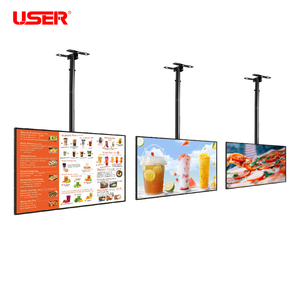
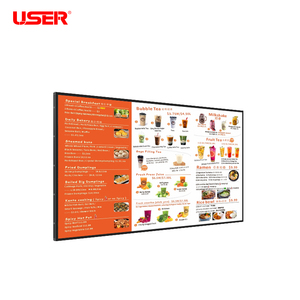
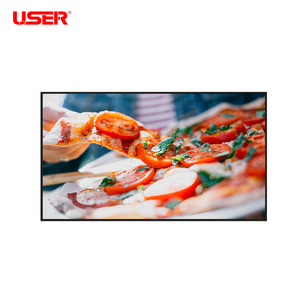
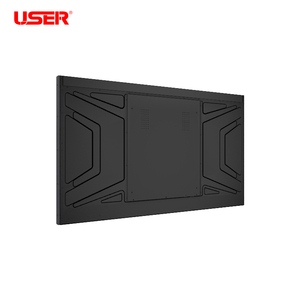

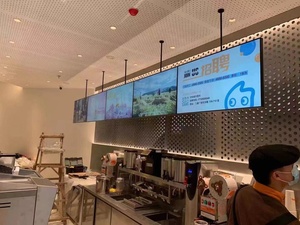
The digital menu board for restaurant comes in different types. These types include the following:
Single-Screen Digital Menu Boards
A single-screen digital menu board is the most basic and common type used in restaurants. It refers to the use of one screen to showcase the menu. This is ideal for small establishments or those with a simple menu. For instance, cafes and quick-service restaurants. It allows them to focus on displaying key menu items, prices, and daily specials.
Multi-Screen Digital Menu Boards
Multi-screen digital menu boards, as the name suggests, use multiple screens to display the menu. Large and complex restaurants, fast food chains, and those that offer a wide variety of products or have changing menus frequently benefit from this system.
Group of screens can be used in one menu board system. For instance, they can be deployed in different sections of the restaurant. These screens can also be used to display promotional content and nutritional information. This helps to create a dynamic and engaging environment.
Interactive Digital Menu Boards
Customers can use interactive digital menu boards to touch the screens to view the menus. They can use the screens to customize their orders or to check nutritional information. Restaurants that offer customization options benefit most from this type of menu board. These include pizzerias and sandwich shops.
Moreover, interactive boards can also help reduce the strain on staff during busy hours. This is because they allow customers to place their orders directly on the screen.
Cloud-Based Digital Menu Boards
A key feature of a cloud-based digital menu board is its content management system. This allows users to update their boards remotely via the internet. For example, a restaurant with locations in multiple cities can have consistent branding across all its outlets. However, it can also make changes to one location's menu or promotion in real time.
This type of menu board is especially useful for businesses that need to frequently update their content. A good example is restaurants that run seasonal promotions or change their menu regularly.
Outdoor Digital Menu Boards
These are durable menu boards. They are built to survive different weather conditions. These boards are usually brighter than indoor versions. This is because they have to ensure visibility in all weather conditions, including full sunlight. They also have increased protection against elements like rain and wind.
The outdoor digital menu board makes it possible to reach customers before they enter the restaurant. They entice those who are driving or walking past the establishment.
Integrated POS and Menu Board Systems
Some advanced menu boards can integrate with a restaurant's point-of-sale (POS) system. This allows for real-time updates based on sales, inventory, or time of day. For example, if a certain menu item is sold out, the digital menu board can automatically update to remove that item.
This integration can streamline operations and ensure that the menu board always displays accurate information. It does so with minimal input from staff. This is ideal for restaurants with high turnover or those that need to quickly adapt to changes in supply.
Digital menu boards are primarily used to display menu items in restaurants. They do more than just display static images on a screen. They allow for dynamic content. This means that businesses can highlight different menu items at different times of the day. It can be breakfast items in the morning and dinner specials in the evening.
The boards can also be used to display high-quality images, videos, and promotional deals. This helps to engage customers more than a traditional paper menu. For restaurants with multiple locations, digital menu boards can be managed from one central location in the cloud. This saves time and ensures consistency across all platforms.
Several features of digital menu boards for restaurants make them more appealing than traditional menu boards. Some of these features include the following:
The design of a digital menu board, however, goes beyond just aesthetics. It has to take into consideration the layout, color scheme, and typography used. All these elements are vital in creating a visual impact and ensuring the information is easily readable. This, therefore, improves the overall customer experience.
Good designs will also make sure that the menu is well-organized, with categories clearly defined. This helps customers make quicker decisions. The use of bright and contrasting colors can also highlight specific items or promotions. Meanwhile, the overall design should align with the branding of the restaurant so it stays consistent.
Digital menu boards are a worthy investment for restaurants. One key advantage is they can reduce printing and labor costs over time. Traditional menu boards require constant printing and updates. This is especially if there are changes in prices, menu items, or promotional offers.
Digital boards, on the other hand, allow for quick, easy, and cheaper updates. Restaurants with seasonal menus or frequent promotions benefit greatly from this flexibility.
Furthermore, engaging and dynamic content can boost sales. This is especially if the restaurant uses appealing visuals to promote high-margin items or limited-time offers. Research has shown that high-quality images can increase customer spending. This is by up to 20% as they entice customers to try new items or upgrade their meals.
Another commercial benefit is increased customer engagement. The vibrant visuals and interactive capabilities of digital boards capture customer attention. They create an improved overall dining experience.
This will lead to increased customer satisfaction, brand loyalty, and word-of-mouth advertising. These factors ultimately impact the restaurant's revenue in the long run.
Digital menu boards have several uses beyond the basic display of food and drink offerings. Some of these uses include the following:
The selection of a digital menu board for a restaurant depends on various factors. These factors impact functionality, cost, and overall effectiveness. Business owners can consider the following factors for a more effective selection:
Screen Size and Resolution
Screen size is one of the important factors to consider when selecting a digital menu board. Digital menu boards can range from small tablet-sized screens to large, wall-mounted displays. To select the ideal size, one must consider the available space in the restaurant and the viewing distance.
Restaurants with large open areas require larger screens. This will ensure the menu is visible from all distances. Tabletop boards in small cafes can get away with smaller-sized screens. Resolution is also crucial. Larger displays require higher resolutions. A good example of it is a full HD or 4K resolution. It prevents pixelation and ensures that images and text appear sharp and clear.
Content Management System (CMS)
Restaurants should also ensure their digital menu boards have user-friendly content management. They should allow for easy updates and scheduling of menu items, prices, and promotional content. They need to look for a CMS that offers drag-and-drop functionality. This makes even non-technical users capable of managing the content effectively.
Indoor vs. Outdoor
The type of restaurant should also determine which digital menu board they will choose. These can be either indoor or outdoor boards. Outdoor boards have to be built to withstand different types of weather. They also have brighter displays to ensure visibility in all weather conditions.
Outdoor digital menu boards also have increased durability and protection. It can be against rain, wind, and extreme temperatures. Indoor boards, meanwhile, offer a wider variety of display options. These options include everything from small screens to large wall-mounted displays.
Interactive Features
Digital menu boards with interactive features such as touchscreens can enhance customer engagement. This is particularly useful for restaurants that offer customizable orders. These include build-your-own pizzas or salads. Interactive boards allow customers to input their preferences directly. This reduces wait time and enhances the overall dining experience.
Budget
Digital menu boards can be expensive to implement. Business owners have to consider their budget when selecting one. They should weigh the costs against the potential benefits. Keeping in mind the long-term return on investment the boards can offer. By carefully considering these factors, restaurant owners can choose the best digital menu board that meets their specific needs.
Yes, they can. Digital menu boards can be used to promote seasonal specials, discounts, bundles, and new offerings. This is particularly useful for limited-time promotions or new product launches that require quick dissemination of information.
It is definitely worth it for small restaurants to invest in digital menu boards. There is a flexible and fully customizable system in place. This system allows for quick updates and high-impact promotions. It can greatly enhance customer engagement and streamline menu management.
Yes. A cloud-based content management system (CMS) allows restaurant owners to update their boards from anywhere with an internet connection. This is incredibly useful for chains or franchises with multiple locations.
The size of a digital menu board will largely depend on the available space in the restaurant. It will also depend on the viewing distance. A digital menu board for a drive-thru should be large enough for customers in their cars to read comfortably.
Yes, there are specifically designed outdoor digital menu boards that are weatherproof. They are durable enough to withstand rain, heat, cold, and even wind. They are also equipped with brighter displays for better visibility in sunlight.